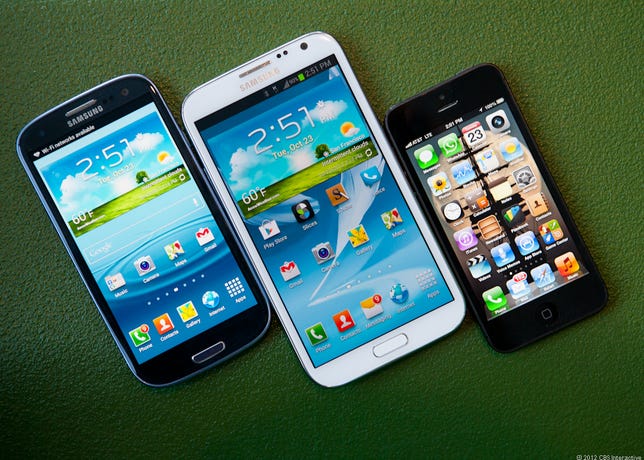Internal memory is probably one of the least sexy features of a smartphone. But as your smartphone replaces your point-and-shoot camera, MP3 music player, portable gaming device, GPS navigator, and in some cases your portable video player, it’s something you have to think about when buying a new device.

While some devices allow you to add memory via a microSD card, others don’t. And when you run out of internal memory on your device, you’re forced to make some tough choices. Do you delete your kids’ first birthday pictures or those videos from your last vacation? Maybe you need to start getting rid of all those apps.
In this edition of Ask Maggie, I help a reader decide how much memory he needs when picking out a new smartphone. And I offer my opinion on the “phablet” smartphone market created by Samsung’s Galaxy Note.
Storage woes
Dear Maggie,
For a few months now, I’ve been contemplating buying a new smartphone. My plan has been to get the Galaxy S3 32GB on Black Friday, when I hope it will go on sale. But then the Samsung Galaxy Note 2 was announced. I really like the bigger size of the “phablet,” and the S Pen capability. I’m hooked on all the other specs of the Note 2. But the one thing I don’t like is the 16GB of internal storage.
I plan on having this phone for several years, so getting a device with the best specs, like a quad-core processor, 2GB of RAM, and LTE, is important to me. But I am worried that after a year or two, the 16GB of storage won’t be enough for me. I would hold off on buying a new phone if I could expect a 32GB model of the Note 2 sometime in the near future. Do you think my storage concerns are valid? And do you think the end of the year is a likely time period for the release of the 32GB model?
Thanks, Steve
Dear Steve,
You bring up a very interesting topic. The heart of the question really is how much internal storage do you need on a smartphone?


Josh Miller/CNET
It’s like asking a New Yorker how much closet space she needs. The answer to both of these questions is that you can never have too much storage space, but you can certainly learn to live with whatever you can afford.
The reality is that memory storage on your phone and closet space in high-rent cities, like New York, don’t always come cheap. Take the iPhone as an example. A 16GB version of the iPhone 5 is $199 with a two-year contract. But that price jumps $100 if you want the 32GB version. And it jumps another $100 if want 64GB of storage. What this means is that you need to figure out how much more you’re willing to pay to keep all those pictures, videos, and apps that eat up your device’s storage.
Luckily, most people don’t need to store their entire music collection, their whole library of videos, or a lifetime worth of pictures on their smartphones. So for price sensitive consumers, getting a device with less storage is viable if they don’t mind limiting and managing what they store on those devices. But some people can’t live without variety. And they hate making those tough decisions about what to save and what to throw out.
Making the problem even more complicated is the fact that smartphone screen resolution has gotten much better. And this means there are more high definition movies, HD apps, and HD games for your phone. Add the fact that the cameras on these devices have also improved, and even storing photos and video you’ve taken on your smartphone will eat up a lot of storage.
While some people may say that it’s wise to get as much storage on your device as you can afford, the flip side is that you could still be paying for storage that you won’t actually need. And that is simply a waste of money. This is the same conundrum that many people face when they’re evaluating data plans. No one wants to go over their monthly usage limit. But buying a huge data package or keeping an unlimited data plan when you barely use 500MB worth of data per month is a waste.
Related stories
- Samsung Galaxy Note 2 (review)
- Samsung Galaxy S3 (review)
- Help! I’m confused about storage on my smartphone
The good news is that it’s not always an either/or situation if you can find a device that has a memory expansion slot, which will, of course, let you add storage to your device. Keep in mind that not all apps can be stored on external memory cards. But if you can move your media around so that things that can be stored on an external storage card are stored there, it will free up space for the content that can’t be stored externally. It’s like adding an extra closet to your apartment on the cheap.
32GB is better, but… To get a better gauge for how much storage average smartphone users should get on their phones, I took an unscientific survey of my CNET colleagues. I asked them what they thought the minimum amount of storage would be that they’d recommend to someone getting a smartphone. And I asked them how much they had on their own devices. The results? Almost all my colleagues think 32GB of storage should be the minimum. But a few people said they always opt for the most storage they can get.
“I really debated how much storage I needed when I was buying my new iPhone,” CNET Reporter Shara Tibken replied in response to my questionnaire. “But I ultimately went with 64GB. I probably don’t really need that much storage on a phone (that’s the minimum I’d accept for a tablet), but I figured I might as well get it now since you can’t upgrade the storage like you can in a PC.”
CNET News Executive Editor Roger Cheng said he wished he had ponied up the extra $100 for a 64GB version of the iPhone 5 instead of the 32GB version he bought. Roger said he doesn’t store music on his phone, but the more data-intensive apps and pictures he likes to store are what eat up most of his space.
Ben Dreyfuss, a member of CNET’s social-media team, said he used to be OK with 16GB of data on his phone. “But as photos have gotten better and apps have gotten bigger it just won’t do,” he said. “I imagine in a few years I’ll have to go full 64GB, but for now 32GB is perfect.”
So what should you do? I’ve got some good news for you. And some bad news. First the bad news. The Samsung Galaxy Note 2 comes in three flavors of storage 16GB, 32GB, and 64GB. But the U.S. carriers are selling only the 16GB version, as you noted in your question. I asked a Samsung representative why this was the case, and he couldn’t offer me an answer. He also wouldn’t say when or if a 32GB model will be coming to the U.S. market.
But that doesn’t mean all hope is lost for you. The good news is that the Galaxy Note 2 comes with a microSD slot that will let you add additional storage if you need it. CNET Reviews editor Jessica Dolcourt said those expansion slots are important in future-proofing your device. In fact, Jessica said she thinks 16GB of storage is plenty so long as you have an expansion slot to add more memory.
Laura Cucullu, another CNET staffer, said she’s made it more than three years with the 16GB SanDisk card she has in her smartphone.
The bottom line: It sounds like you’re willing to wait a little bit longer for a new smartphone. So my advice to you is to wait until the end of the year to see if the 32GB version of the Galaxy Note 2 comes to U.S. carriers. But if it doesn’t, I wouldn’t fret too much. The microSD card slot gives you a lot more flexibility in the future. I think between the 16GB of on-device storage plus the microSD expansion slot for a memory card, you’ll have plenty of storage for apps, photos, video, and music.
That said, if you were eyeing a device without a microSD memory expansion slot, such as the iPhone 5, I’d be sure to select a version that has 32GB of on-device memory storage.
I hope this advice is helpful.
Samsung Galaxy Note 2 hands on (photos)






The Phablet
Dear Maggie,
I value and trust your knowledge on smartphones and tablets. So I’m very interested in your take on the Samsung tablet/smartphone (smarttablet or phablet) market, When will the other manufacturers enter the smarttablet/phablet market?
Best wishes, Michael
Dear Michael,
There were a lot of skeptics out there when Samsung first introduced the oversize Galaxy Note. I’ll admit that initially I thought it looked pretty silly. It seemed like something out of a novelty shop. All I needed was some oversize sunglasses, a really big pencil, and my jumbo smartphone.


Stephen Shankland/CNET
But the truth is that Samsung was onto something with that 5-inch-plus device, which really is a cross between a smartphone and a tablet, at least in size. The S-Pen stylus that lets people write on the device to take notes on a picture, Web page, or in a notepad, really appeals to some users. And there are lots of folks who seem to like the bigger size. Anecdotally, I’ve talked to lots of business travelers who’d rather have this device than carry around both a tablet and a smartphone.
Samsung said the original Galaxy Note sold well. But the second one seems to be even more popular. In the first 30 days the product was on the market, the company said it sold 3 million Galaxy Note 2s. Samsung hit that mark three times faster than it did with its predecessor. It took about 90 days for Samsung to sell 3 million of the original Galaxy Notes.
What this tells me is that there’s definitely demand for the bigger phablet. And it looks like other manufacturers have already taken notice. LG, HTC, and now Sony all have competing products either on the market or in the works. LG’s 5-inch phablet is called the Intuition and it’s available on Verizon Wireless. HTC is supposedly working on the Droid DNA, which is also expected to show up on Verizon’s network. And there are some rumors floating around that Sony may be developing its own phablet.
At any rate, over the next six months I expect to see a lot more of the 5-inch-plus smartphones on the market. So if a big smartphone/tablet is on the top of your wishlist, you should have several options in the near future.
Thanks for your question. And I hope this answered it for you.
Ask Maggie is an advice column that answers readers’ wireless and broadband questions. The column now appears twice a week on CNET offering readers a double dosage of Ask Maggie’s advice. If you have a question, I’d love to hear from you. Please send me an e-mail at maggie dot reardon at cbs dot com. And please put “Ask Maggie” in the subject header. You can also follow me on Facebook on my Ask Maggie page.



